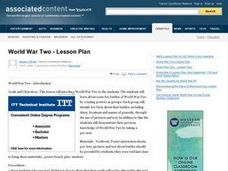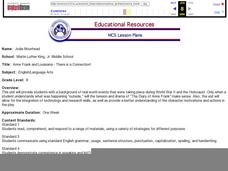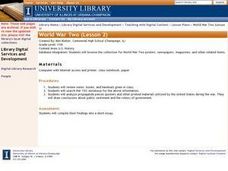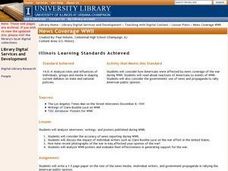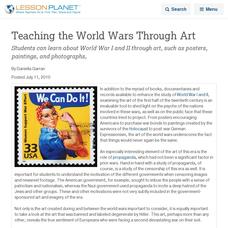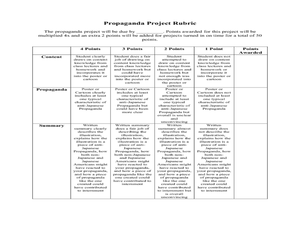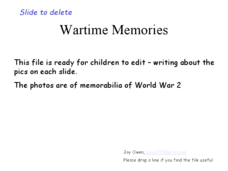Curated OER
Changing Perspectives on the Japanese Internment Experience
Students explore the issue of Japanese-American internment. In this World War II instructional activity, students analyze historical biases regarding Japanese-American internment as they analyze literature, research print and Internet...
US National Archives
WWII: Western Europe 1939-45 – Invasion
Without the benefit of history, Western Europe in the 1940's had no idea what was about to befall them. Class members use primary sources, including political cartoons, videos, and internal documents, to analyze how much of a threat...
Curated OER
Studying Oral Histories
Students read stories from the 1930s and 1940s. They discuss homelife during World War II. students examine changes in lifestyle and technology that may take place in the future.
Curated OER
War Stories
Students watch the film "The Perilous Fight: America's World War II in Color". Using the film, they work together to develop proper interview questions to use while talking to World War II veterns. After the interview, they research...
DocsTeach
Letter to Truman about the Manhattan Project
Delve into the past to understand the opposition to the Manhattan Project. An interesting activity is designed to be completed in pairs, groups, or individually. Scholars analyze historical documents, complete an online worksheet, and...
Curated OER
What is to Become of the World After the War?
Students analyze primary sources regarding World War II. In this World War II lesson, students read "The Atlantic Charter," and respond to questions about the document.
Curated OER
World War II
Students create a Powerpoint presentation covering key information regarding a World War II battle and present the information to the class in the form of an oral presentation. They then will turn in a summary report including two...
Curated OER
World War II Memories
Fifth graders utilize primary sources provided to formulate questions to prepare for an interview. Veterans and civilians who lived during World War II are interviewed by students and their work displayed on a web site.
Curated OER
Anne Frank and Louisiana - There is a Connection!
How is Louisiana connected to the Holocaust? After reading The Diary of Anne Frank, eighth graders complete a research report about a survivor of the Holocaust who currently resides in Louisiana. Though the idea is a good way to connect...
National Endowment for the Humanities
How "Grand" and "Allied" Was the Grand Alliance?
Learn more about the Grand Alliance with a scaffolded lesson plan that includes four activities. Class members use primary sources to complete a map exercise, understand the goals and objectives of each individual nation, and participate...
National Woman's History Museum
Create your own Women’s History Museum
Celebrate Women's History with a museum display. Divide the class into seven groups and assign each a different historical topic/time period. Each group member researches a different woman of that time period and creates an exhibit that...
Curated OER
Volunteering From Camp
Eleventh graders examine the imprisonment of Americans during WWII. In this American History lesson, 11th graders participate in webquest. Students analyze various resources on the internet and discuss self sacrifice and their own...
Curated OER
World War Two- Lesson #2 of 3
Eleventh graders search an online database for World War II posters and other propaganda materials. They write an essay about public sentiment of the era based on their research.
Curated OER
News Coverage WWII
Students explore how Americans were affected by news coverage of World War II.
Curated OER
Teaching the World Wars Through Art
Students can learn about World War I and II through art, such as posters, paintings, and photographs,
Curated OER
Fighting for Democracy, Fighting for Me
Students explore the contributions of African Americans, Japanese Americans, and Mexican Americans in World War II. In this World War II lesson, students research Internet and print sources regarding the treatment of the ethnic groups...
Curated OER
Fighting for Democracy, Fighting for Me
Ninth graders investigate specific individuals involved in Operation Iraqi Freedom and working backward to stories from World War II. In this US History lesson, 9th graders read documents that depict the conflicts faced by individuals...
Curated OER
Navajo Code Talkers
Pupils investigate the Navajo Code Talkers and their role in World War II. They complete a Webquest, explore various websites, encode a short message, analyze maps, answer discussion questions, and read newspaper articles about secure...
Curated OER
Conscience and Public Service
Students study conscientious observers (COs) in the Civilian Public Service (CPS) during World War II. They explore how the media sources influence public opinion and policy makers, and complete a writing assignment about the topic.
Curated OER
Japanese American Internment: Examining Racial Tensions
High schoolers discover how racial tension led to Japanese Internment. For this World War II lesson, students analyze political cartoons and posters related to the movement of Japanese-Americans to internment camps in the wake of the...
Curated OER
The Holocaust
Eighth graders consider how something like the Holocaust could happen. In this Holocaust lesson, 8th graders analyze German propaganda that was used to garner support for World War II. Students discuss which pieces of propaganda were the...
Common Core Sheets
Reading a Timeline
Sometimes the most important details of an informational text aren't within the text at all. Teach your class how to read timeline with a set of activities that prompts them to find specific dates and events on the timelines, as well as...
Curated OER
Wartime Memories: Learner Template
Here is a wonderful template for learners to use as a way to show what they know about WWII. Each slide is prepared with three to four photos of wartime memorabilia for your class to research and write about. There are nine slides total...
Curated OER
WW II Magazine
Eleventh graders search the database for pictures of WW II, photographs, posters, etc. They use the documents to support writing two magazine articles. The magazine articles be a minimum of 500 and maximum 1000 words.








